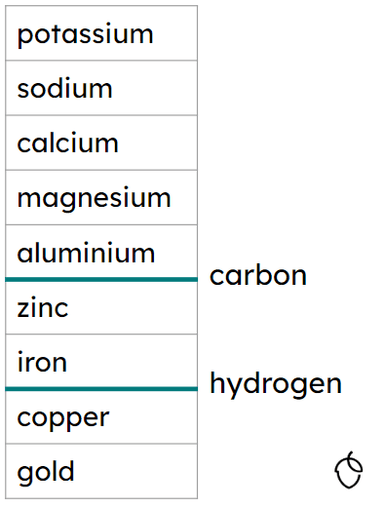Alternative methods of extracting metals: phytoextraction and bioleaching
I can describe how metals are extracted by phytoextraction and bioleaching and compare different methods of metal extraction.
Alternative methods of extracting metals: phytoextraction and bioleaching
I can describe how metals are extracted by phytoextraction and bioleaching and compare different methods of metal extraction.
These resources will be removed by end of Summer Term 2025.
Lesson details
Key learning points
- In phytoextraction, metal is extracted from a crop of plants that absorb metal ions through their roots.
- In bioleaching, metal is extracted from bacteria that extract metal from an ore.
- Electrolysis is a process used to separate metals from their compounds.
- There are advantages and disadvantages associated with each method of extracting metals.
Keywords
Low-grade ore - An ore is a rock that contains metals or metal compounds. A low-grade ore contains a lower percentage of metal or metal compound than a high-grade ore.
Phytoextraction - Phytoextraction is a method of extracting metals by growing plants in soil containing low-grade ore.
Displacement - Displacement is where a more reactive element takes the place of a less reactive element in a compound.
Electrolysis - Electrolysis is a process that uses electricity to break down a compound.
Bioleaching - Bioleaching is a method of extracting metals by growing bacteria on low-grade ores to produce a leachate.
Common misconception
Students struggle to distinguish between phytoextraction and bioleaching.
Reinforce that the term 'phyto' is a combining form meaning 'plant'.
To help you plan your year 11 combined science lesson on: Alternative methods of extracting metals: phytoextraction and bioleaching, download all teaching resources for free and adapt to suit your pupils' needs...
To help you plan your year 11 combined science lesson on: Alternative methods of extracting metals: phytoextraction and bioleaching, download all teaching resources for free and adapt to suit your pupils' needs.
The starter quiz will activate and check your pupils' prior knowledge, with versions available both with and without answers in PDF format.
We use learning cycles to break down learning into key concepts or ideas linked to the learning outcome. Each learning cycle features explanations with checks for understanding and practice tasks with feedback. All of this is found in our slide decks, ready for you to download and edit. The practice tasks are also available as printable worksheets and some lessons have additional materials with extra material you might need for teaching the lesson.
The assessment exit quiz will test your pupils' understanding of the key learning points.
Our video is a tool for planning, showing how other teachers might teach the lesson, offering helpful tips, modelled explanations and inspiration for your own delivery in the classroom. Plus, you can set it as homework or revision for pupils and keep their learning on track by sharing an online pupil version of this lesson.
Explore more key stage 4 combined science lessons from the Using Earth's resources unit, dive into the full secondary combined science curriculum, or learn more about lesson planning.

Equipment
None required.
Licence
Starter quiz
6 Questions



